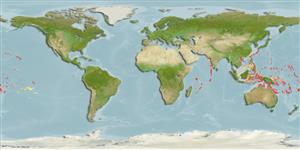>
Kurtiformes (Nurseryfishes, cardinalfishes.) >
Apogonidae (Cardinalfishes) > Apogoninae
Etymology: Apogon: Greek, a = without + Greek pogon = chin, beard (Ref. 45335); caudicinctus: From the Latin word 'cauda' for tail and 'cinctum' for girdle or belt, in reference to the broad blackish bar across the posterior caudal peduncle and base of caudal fin.
More on authors: Randall & Smith.
Environment: milieu / climate zone / depth range / distribution range
ນິເວດວິທະຍາ
ສັດທະເລ ກ່ຽວກັນຫີນ; ລະດັບຄວາມເລິກ 0 - 40 m (Ref. 126002). Tropical; 30°N - 22°S, 54°E - 130°W
Indo-Pacific: Réunion Island, and Mauritius (Ref. 33390) east to the Pitcairn Group, including Rapa Island in the south-central Pacific, north to Bonin/ Ogasawara Islands (Ref. 33390) and Ryukyu Islands.
ຂະໜາດ / ນ້ຳໜັກ / Age
Maturity: Lm ? range ? - ? cm
Max length : 12.0 cm SL ຕົວຜູ້/ບໍ່ມີເພດ; (Ref. 126002)
ຄີ (ໜາມ)ແຂງຢູ່ຫຼັງປາ (ທັງໝົດ) : 7; ຄີຫຼັງຂອງປາ (ຄີອ່ອນ) (ທັງໝົດ) : 9; ຄີ(ໜາມ) ແຂງຢູ່ຄີກົ້ນປາ
ກຸ່ມປາກະດູກແຂງ
ຄວາມຖີ່ຂອງກຸ່ມຖ່າຍທອດພັນ
ປາທີ່ມີການເຄື່ອນຍ້າຍຈາກທະເລໄປຫານ້ຳຈືດ ແລະນ້ຳຈືດຫາທະເລ
ປາທີ່ມີການເຄື່ອນຍ້າຍຈາກທະເລແລະໄປໄຂ່ຢູ່ນ້ຳຈືດ
ຄີກົ້ນຂອງປາ
ສັດທີ່ມີກະດູກສັນຫັຼງ
ການຖ່າຍທອດທາງກຳມະພັນຈາກພໍ່ແມ່ຫາລູກ: 2; ຄີກົ້ນຂອງປາ: 8; ສັດທີ່ມີກະດູກສັນຫຼັງ: 24. Distinguished by having the following characteristics: dorsal-fin rays VI-I, 9; anal-fin rays II, 8; pectoral-fin rays 12; pelvic-fin rays I, 5; pored lateral line scales 24; predorsal scales 7; circumpeduncular scales 12; total gill rakers 16, developed gill rakers 10; second spine length of first dorsal fin 1.8 in head length (Ref. 93839). Body color transparent red, edges of dorsal body scales dark, diffused blackish bar across posterior half of caudal peduncle; depth 2.95-3.45 in SL. Long and slender caudal peduncle 3.30-3.35 in SL.
Found in reefs or rocky substrate with caves and ledges at depths of less than 12 m (Ref. 10632); to 40 m (Ref, 126002).
Life cycle and mating behavior
ການຈະເລີນເຕັມໄວ | ການສືບພັນ | ການວາງໄຂ່ | ໄຂ່ | ຄວາມດົກຂອງໄຂ່ປາ | ຕົວອ່ອນ
Mouthbrooders (Ref. 240). Distinct pairing during courtship and spawning (Ref. 205).
Randall, J.E. and C.L. Smith, 1988. Two new species and a new genus of cardinalfishes (Perciformes: Apogonidae) from Rapa, South Pacific Ocean. Am. Mus. Novit. (2926):1-9. (Ref. 10632)
IUCN Red List Status (Ref. 130435: Version 2024-2)
Threat to humans
Harmless
Human uses
ເຄື່ອງມື
Special reports
Download XML
ແຫຼ່ງອີນເຕີເນັດ
Estimates based on models
Preferred temperature (Ref.
123201): 25.3 - 29.3, mean 28.5 °C (based on 1624 cells).
Phylogenetic diversity index (Ref.
82804): PD
50 = 0.5000 [Uniqueness, from 0.5 = low to 2.0 = high].
Bayesian length-weight: a=0.01096 (0.00469 - 0.02561), b=3.08 (2.90 - 3.26), in cm total length, based on LWR estimates for this Genus-body shape (Ref.
93245).
ຊັ້ນເຂດຮ້ອນ (Ref.
69278): 3.6 ±0.5 se; based on size and trophs of closest relatives
ຄວາມຢືດຢຸ່ນ (Ref.
120179): ສູງ, ປະຊາກອນຕຳ່ສຸດທີ່ໃຊ້ເວລາສອງໜ້ອຍກວ່າ 15 ເດືອນ (Preliminary K or Fecundity.).
Fishing Vulnerability (Ref.
59153): Low vulnerability (10 of 100).
Nutrients (Ref.
124155): Calcium = 209 [120, 445] mg/100g; Iron = 1.28 [0.69, 2.17] mg/100g; Protein = 19 [18, 20] %; Omega3 = 0.161 [0.085, 0.313] g/100g; Selenium = 25.7 [11.7, 53.9] μg/100g; VitaminA = 96.9 [30.2, 309.0] μg/100g; Zinc = 2.6 [1.6, 3.9] mg/100g (wet weight);
